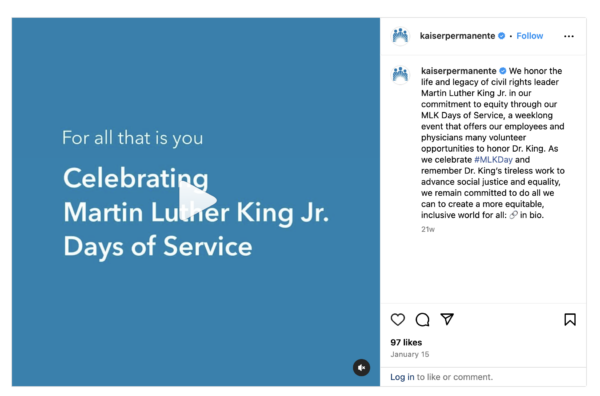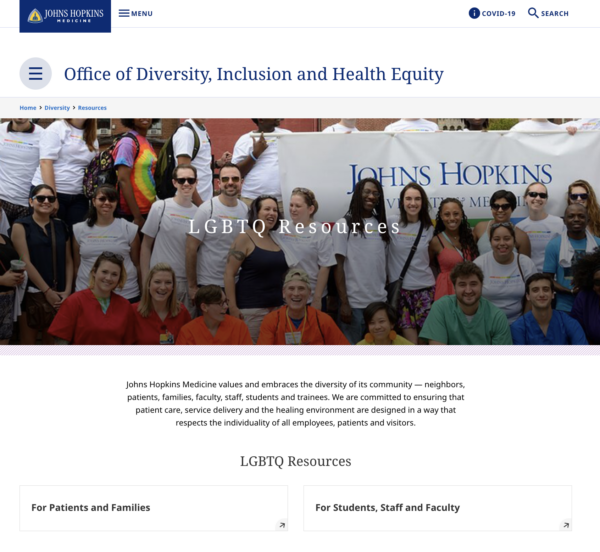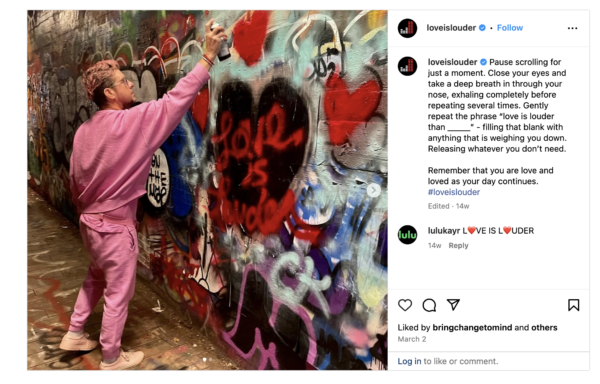Brands’ words and actions — including yours — matter.
As politics, health care, and other cultural topics become more polarized, being authentic about your values and causes can build audience loyalty.
Over half of young U.S. adults (ages 18 to 29) want businesses to take a public stand on current events, while 35% of those 45 and older do, according to a 2023 Bentley-Gallup poll.
How to know when to weigh in
No organization needs to acknowledge every issue. To decide when to speak up, your leadership team should reflect on these questions:
- Who are we as a brand? Does this issue intersect with our vision or brand mission statement? Is this an important topic, and do we have something meaningful to say? How will we demonstrate to our audience that we are accountable for our stance?
- What do our customers and employees expect? Are consumers asking or commenting about our brand’s stance on the issue? Do our employees want us to take a position?
- What do we stand for? What are our company’s core values? Does it make sense to say something or stay silent on this issue?
- What will our silence say? Saying nothing can sometimes say more than a statement could.
- Who should say something? In general, the CEO or leader of the organization should give voice to the position. But if individuals from marginalized communities or people personally affected by an issue work for your organization, consider encouraging them to share their stories or giving them a voice as well.
How to engage with your audience about social issues
When you want to weigh in on a social or political issue, follow these tips to connect with your audience and learn from brands that do it well.
1. Be unique in your messaging
When Martin Luther King Jr. Day rolls around every January, brands predictably trot out some version of his “I Have a Dream” speech on their social media accounts. Unfortunately, that messaging has become so overused that it barely resonates.
Avoid the predictable. Be thoughtful and share with vulnerability to deepen your connection with loyal customers.
Example: In 2024, Kaiser Permanente honored Martin Luther King Jr. Day by sharing its past, present, and future commitment to advancing equality and inclusion. In an Instagram post, the company wrote about its “Martin Luther King Jr. Days of Service” — a week-long event offering Kaiser Permanente employees and physicians the opportunity to volunteer in honor of King.
The company also highlighted lesser-known aspects of King’s advocacy for economic justice and health care equality in a blog post that reinforced Kaiser Permanente’s commitment to social justice and equity in health care. The company’s chair and chief executive officer, Greg Adams, received the Dreamer Award for advancing a more just, equitable world and health care system.
2. Make the message meaningful to your brand
Do you want to release a statement about a cause that aligns with your brand’s value? Stop. Take a step back. Figure out how to say something in the most meaningful way possible. How does this cause intersect with your brand? Acknowledging that connection makes a stronger impact.
Example: In the mid-1980s, Procter & Gamble found success with Peridex, a mouthwash used to treat thrush in patients with HIV/AIDS. But despite selling it to the LGBTQ+ community, P&G did not have protections for their LGBTQ+ employees.
Recognizing the importance of this brand alignment, P&G employee and activist Michael Chanak and his colleagues worked to change that. In 1992, P&G became one of the first Fortune 500 companies to add sexual orientation to its equal employment opportunity statement.
This 19-minute video celebrates the action’s 20th anniversary and P&G’s continued commitment to the communities it serves. The message aligns with its brand values and enhances its reputation.
3. Be accountable to your audience
It’s one thing to say your company fights for a cause, but it’s better to show how it’s doing it. And if your brand contributes to a societal problem, acknowledge how your organization is combatting it. Show your audience you care and are working toward change.
Example: When faced with criticism of racial inequities in health care, Boston Medical Center acknowledged the issues and outlined its steps to address them in this 2023 publication, Together @ BMCHS: Diversity, Equity, and Inclusion Year in Review.
Boston Medical Center also developed a glossary of terms related to justice, equity, and belonging. Its DEI in Action webpage provides transparency about the brand’s work to advance the mission within the health system and local community.
4. Provide resources to support the causes
Go beyond statements. Providing resources or support to people affected by your cause makes your message more impactful.
Example: Johns Hopkins Medicine celebrated LGBTQ+ Pride Month by hosting discussion panels, workshops, and film screenings. It made the support statement and then took action. Its website links resources offered through an Employee Assistance Program to support LGBTQ+ students, staff, and faculty. It also includes a resource section for patients and families, emphasizing mental health and self-care.
5. Don’t think you have to be political to take a stand
In a polarized political landscape, some people equate standing up for a social cause with making a political statement. But that doesn’t have to be the case. Organizations can focus on making a difference in causes that don’t fall on any side of the political spectrum.
Example: More than 600 hospitals have partnered with Vot-ER, which helps people visiting emergency rooms or health care institutions register to vote. They don’t advocate how people should vote but encourage visitors to have a say in democracy.

6. Make statements your audience cares about
You don’t have to take a stand for every issue. Your leadership team likely determines which issues are important to your brand and audience. You can help them by using your personas to see if the issue resonates with your audience. Of course, you may consider some issues so critical that it’s worth adding your voice even if some consumers don’t agree with your position.
Example: Jed Foundation’s Love is Louder project speaks to its target audience through stories, messages, and opportunities to support mental-health challenges faced by youth. It published content on social media, partnering with media, brands, and individual storytellers to help its audience feel seen and connected.
In this Instagram post, the foundation uses a visual of someone spray-painting a heart above the phrase “Love is louder” on a brick wall. The caption reads: “Pause scrolling for just a moment. Close your eyes and take a deep breath in through your nose, exhaling completely before repeating several times. Gently repeat the phrase “love is louder than _____ ” — filling that blank with anything that is weighing you down. Releasing whatever you don’t need. Remember that you are love and loved as your day continues. #loveislouder”
7. Think long term
Don’t be one-and-done about a social cause. Before making a statement or posting about it on social media, know how you will support this cause in the long term. Consider:
- Recurring donations to designated charities
- Revamping your organization’s hiring and promotion practices
- Conducting internal training
With ongoing action, consumers will better see the dedication and intentions behind your words.
Example: No short-term initiatives here. Nationwide Children’s Hospital doesn’t just make a statement about the importance of health care access. It provides health care services directly within schools.
The program highlights the hospital’s dedication to fostering healthier communities over time. The long-term plan will make a lasting impact on public health.
Implementing a good decision in a great way
Finding the right way to make a statement can feel like walking a fine line. But with deep thought, internal discussions, and an assessment of your organization’s unique contributions, your brand can help make the world a better place.
Updated from a March 2022 article.
HANDPICKED RELATED CONTENT:
Cover image by Joseph Kalinowski/Content Marketing Institute




